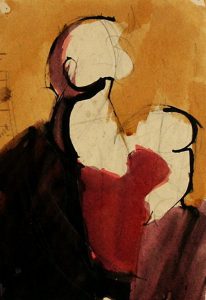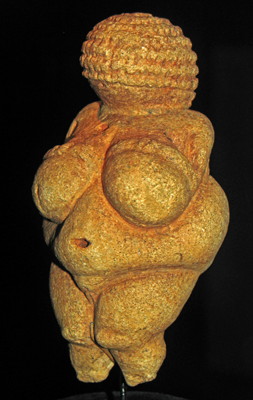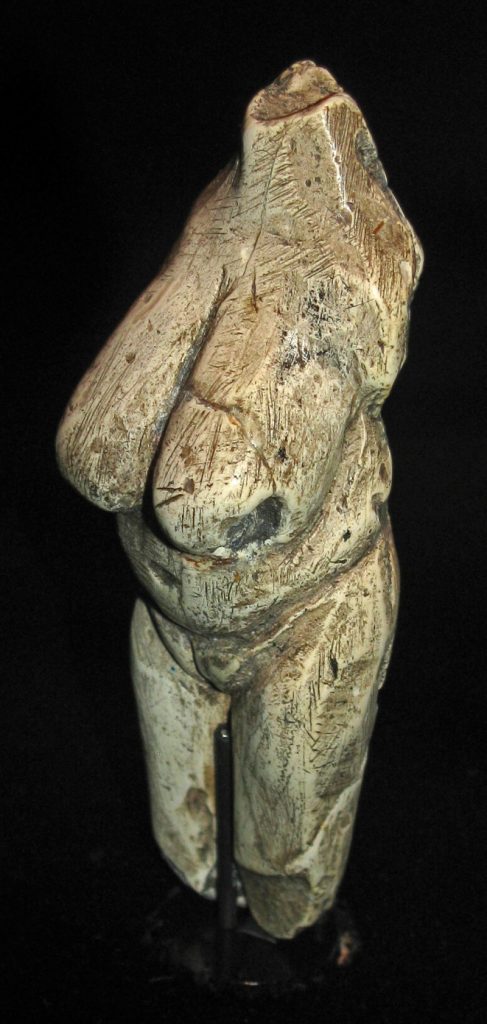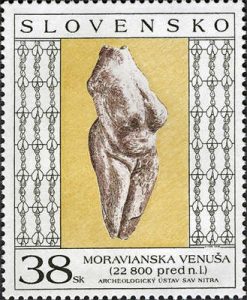Venus contro Venus
Ambrosio Paolo 1964 Acquarello su carta cm.50×40
#J’AMbrosio , #art, #draw, #beautiful, #instangoo, #gallery, #reading, #literature, #stories.
Venus contro Venus
Una esposizione alla Casa della cultura del Giappone a Parigi “Nascita dell’arte nel Giappone preistorico” ci porta a fare qualche considerazione sui progressi significativi acquisiti dagli uomini primitivi che si tradussero in arte in tutte le prime espressioni artistiche. L’Expo ci mostra l’arte sofisticata del periodo Jomon, il periodo dei primi abitanti dell’arcipelago giapponese che si estende da circa il 13000 a.C. fino al 400 a.C. periodo da ricondurre alla fine dell’era glaciale
L’esposizione conta sessanta opere, tra statuine antropomorfe in terracotta, vasetti in argilla, maschere, giare di fondo conico e oggetti della quotidianità vi sono le statuette di donne dalle forme opulente e caratteristiche fisiche particolari di elevata estetica preistorica mai vista. Tutte le opere testimoniano grande tecnica e sofisticata estetica di un popolo pacifico, di cacciatori, pescatori che viveva nei villaggi senza praticare né agricoltura né allevamento, contrariamente alle altre popolazioni dell’epoca neolitica secondo quanto riportato da Le Monde.
L’opera di maggiore attrazione è la Vénus Jomon, scultura in terracotta alta 27 centimetri (epoca fra il 3000 e il 2000 a.C.) dalle generose forme del ventre, seni appena accennati ed occhi semichiusi.
Venus against Venus
An exhibition at the House of Culture of Japan in Paris “The birth of art in prehistoric Japan” leads us to make some consideration of the significant progress made by primitive men who translated into art in all the first artistic expressions. The Expo shows us the sophisticated art of the Jomon period, the period of the first inhabitants of the Japanese archipelago that extends from about 13000 BC. up to 400 B.C. period to be brought back to the end of the ice age
The exhibition has sixty works, including anthropomorphic terracotta statuettes, clay jars, masks, conical bottom jars and everyday objects are the statuettes of women with opulent forms and particular physical characteristics of high prehistoric aesthetics never seen before. All the works bear witness to the great technical and sophisticated aesthetics of a peaceful people, of hunters, fishermen who lived in the villages without practicing agriculture or breeding, as opposed to other populations of the Neolithic age as reported by Le Monde.
The work of greatest attraction is the Vénus Jomon, a 27 cm high terracotta sculpture (between 3000 and 2000 BC) with generous forms of the belly, barely mentioned breasts and half-closed eyes.
Venus Jomon da -3000 – 2000 a.C.
Nel paleolitico superiore si hanno i primi sistemi destinati a conservare le informazioni e a preparare il sistema di comunicazione visiva da ricondurre a manifestazioni della coscienza che nel tempo, agli albori delle civiltà, conducono alla realizzazione, a scopo narrativo, di un contorno schematico dell’oggetto
Nell’istinto emozionale dei primitivi vi era un realismo integrale, una rappresentazione del corpo. Si riscontrano le analogie negli innumerevoli siti archeologici considerando ciò che affermano gli antropologi. La struttura del cervello è analoga in tutti gli uomini ed è utile per catalizzare le forme con dei modelli d’istinto primitivi ove si alternano forme tondeggianti come si riscontra anche nella venere di Willendorf scultura di roccia calcarea alta cm. 11 del paleolitico superiore risalente a -23000 a -19000 anni a. C.
In the Upper Palaeolithic we have the first systems designed to store information and prepare the system of visual communication to be traced to manifestations of consciousness that over time, at the dawn of civilizations, lead to the creation, for narrative purposes, of a schematic outline of the object
In the emotional instinct of the primitives there was an integral realism, a representation of the body. The analogies are found in the innumerable archaeological sites considering what the anthropologists say. The structure of the brain is similar in all men and it is useful to catalyze the forms with primitive instinct patterns where alternating roundish shapes are also found in the Venus of Willendorf sculpture of calcareous rock high cm. 11 of the upper Paleolithic dating from -23000 to -19000 years a. C.
Venus di Willendorf
I siti primitivi popolati dall’uomo sono molti. Gli utensili di pietra tagliata e perfezionata negli anni permettono di lavorare meglio il legno, l’osso e il cuoio. I progressi significativi degli utensili si traducono nelle prime espressioni artistiche che avevano per oggetto anche le pratiche magiche. Anche in questo caso si scoprono preziose statue fra le quali la statuetta di donna ricavata da un osso di mammouth trovata a Moravany nella valle di Vahom. Ufficiamente datata 22800 anni a. C.
The primitive sites populated by man are many. The stone tools cut and perfected over the years make it possible to work better on wood, bone and leather. The significant progress of the tools translates into the first artistic expressions that also included magical practices. Also in this case precious statues are discovered among which the statuette of a woman obtained from a mammouth bone found in Moravany in the valley of Vahom. Officially dated 22800 years a. C.
Venus Moravany cm. 7,6
Nel paleolitico superiore il nutrimento era essenziale e i cambiamenti climatici costringevano a cambiamenti di adattamento repentini. Nel passaggio dal Paleolitico superiore al Neolitico, a causa della riduzione dei ghiacci, la sorgente principale non fu più la caccia ma nascono le prime forme di agricoltura. Nella Slovacchia. con i nuovi coloni dei Balcani apparvero le decorazioni della ceramica ingegnosamente creata.
In questo meeting di donne preistoriche si incontra il realismo integrale con motivi e motivazioni simili in opere eseguite in località e in tempi molto diversi. Le origini di tipo culturale non sono sovrapponibili poiché gli stimoli che gli individui ricevono nell’ambiente in cui vivono sia da bambini che da adulti sono solo in parte simili nella memoria e nell’organizzazione neurale per cui il comportamento sociale è legato alla sfera emozionale con rilevante numero di elementi innati ereditati per via filogenetica. Konrad Lorenz ci dice che gli schemi motori dell’espressione si rivelano identici tra i Papua, gli Indios dell’Orinoco, i Boscimani, gli indigeni australiani, i Francesi e altri rappresentanti della nostra cultura occidentale. Quindi è verosimile che le opere di cui abbiamo parlato siano assimilabili ad un mosaico con le tessere che si compongono in tempi e manualità di origine diversi fatte con diversi scopi, anche propiziatori, ma con una pulsione comune come ci dice Lacan.
La sublimazione con la trasformazione degli impulsi primitivi rinnova appunto la percezione del soggetto. Essa è il contraltare della rimozione (in psicoanalisi) processo che invece tende a
respingere un certo contenuto psichico sino a renderlo innocuo. Nel 1905 Sigmund Freud aveva concettualizzato il termine sublimazione per rendere conto di un tipo particolare di attività umana -creazione artistica, letteraria, intellettuale- senza rapporto apparente con la sessualità ma prendendo la sua forza dalla pulsione sessuale che si trasferisce verso
uno scopo non sessuale caricando di energia oggetti socialmente valorizzati. La trasformazione degli impulsi primitivi e il loro volgersi a mete socialmente accettabili.
In the Upper Paleolithic, nourishment was essential and climate change forced sudden changes in adaptation. In the transition from the Upper Paleolithic to the Neolithic, due to the reduction of the ice, the main source was no longer hunting but the first forms of agriculture were born. In Slovakia. with the new settlers of the Balkans the ingeniously created ceramic decorations appeared.
In this meeting of prehistoric women we meet the integral realism with similar motives and motivations in works carried out in places and in very different times. The origins of a cultural type are not superimposable because the stimuli that individuals receive in the environment in which they live both as children and as adults are only partly similar in the memory and in the neural organization for which social behavior is linked to the emotional sphere with significant number of innate elements inherited by phylogenetic method. Konrad Lorenz tells us that the motor patterns of expression are revealed to be the same among the Papua, the Orinoco Indios, the Bushmen, the Indigenous Australians, the French and other representatives of our Western culture. So it is likely that the works we have talked about are similar to a mosaic with the tesserae that are composed in different times and manual deeds made with different purposes, even propitiatory, but with a common drive as Lacan tells us.
Sublimation with the transformation of primitive impulses renews the perception of the subject. It is the counterpart of the removal (in psychoanalysis) process that instead tends to reject a certain psychic content until it becomes harmless. In 1905 Sigmund Freud conceptualized the term sublimation to account for a particular type of human activity – artistic, literary, intellectual creation – with no apparent relationship with sexuality but taking its strength from the sexual drive that moves towards a non-sexual purpose by uploading socially valued objects to energy. The transformation of primitive impulses and their turning to socially acceptable goals.
Moravany Venus on a Slovakian postage stamp 20 october 2006
Post Slovakia
Riferimenti: Le Monde, Wikipedia





